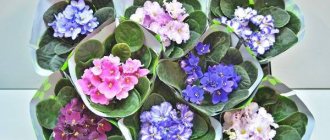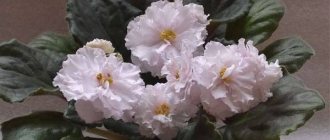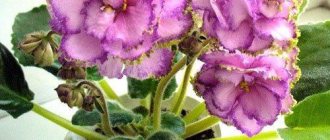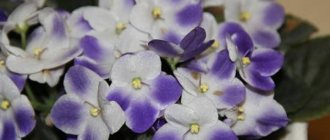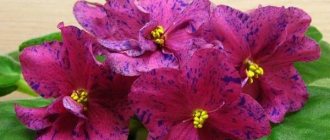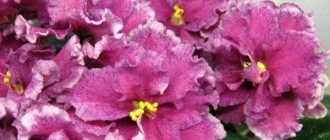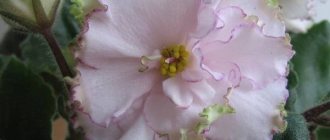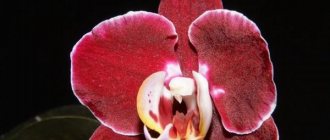Among the huge variety of Uzambara violets, one can distinguish a group of varieties, containing a mention of a particular queen in the title.
Breeders compare violets of this group to royalty
for:
- The rare splendor of their appearance;
- Lush flowering;
- And unusual color tones of the corollas.
The rules for growing “royal” Saintpaulias in indoor culture are not much different from other varieties and hybrids . To preserve their decorative properties and constant flowering, it is enough:
- Maintain comfortable conditions;
- And avoid mistakes in care regimens.
From the group of queen violets, we can recommend the most spectacular varieties , suitable for breeding in the collections of not only experienced, but also novice gardeners. We will talk in more detail about such varieties of violets as Queen of the Elves (Morev), EC Pink Queen, EC Queen of the Ball, EC Queen of Autumn, DEO Queen Elizabeth, EC Queen Margot in the article.
Violet Queen of the Elves
Mysterious violet Queen of the elves.
The variety belongs to the collection developments of Konstantin Lvovich Morev:
- Successful Saintpaulia breeder, known in this field since 1994;
- A student of the famous master of violet breeding B.M. Makuni.
What type of Saintpaulia is it?
Specimens of the Elf Queen can form bushes up to 40 cm in height - the variety belongs to the standard species. Based on the duration of flowering, the plant can be included in the ever-flowering group.
Description
The variety has a fairly compact rosette . The leaves grow in a thick mass of light green color. Leaf blades with wavy edges sit on petioles of a darker tone.
A slight variegation of leaves may unexpectedly appear, which can be passed on to children.
Violet represents varieties with bouquet flowering . Up to 9 buds are formed on each peduncle, opening into double flowers. Medium-sized (about 4 cm) corollas of various shades of pink:
- Edged with a dark stripe;
- And the edges are covered with a thick fringe of pistachio shade.
Peculiarities
The variety does not really like to form a regular contour . Sheet plates:
- They tend to bend in different directions;
- They can hug the pot, which harms the decorative effect of the specimen.
Bushes of different sided configurations .
INTERESTING! The violet is slow in expressing all life cycles. It blooms for a very long time - after one corolla opens, several weeks may pass before the next bud opens. But this feature ensures long-term preservation of violets in a blooming state.
The variety blooms in both hot and cool conditions.
With proper care, it can bloom both in hot and cool conditions for up to 5 months . The duration of flowering depends on:
- Air humidity;
- And regular watering.
Slightly lower temperatures during flowering provoke the formation of very thick fringe on the petals.
Watch the video to see what the Queen of the Elves variety looks like:
How to choose?
Before you get a white beauty, you need to choose the right violet variety. It is best to buy plants in specialized stores, since “counterfeits” (off-grade flowers) are often found on the market.
When purchasing violets, it is important to pay attention to the following indicators
- Color and condition of foliage. The color should be light or dark green without blemishes. If the plant’s leaf cuttings are too elongated, then it is advisable to refuse the purchase. This violet was grown from weak planting material and did not have sufficient lighting.
- External view of the socket. A rosette that is too tight indicates the presence of a disease in the flower.
- Time to buy. Experts recommend purchasing violets in the spring, since in summer and winter their root system does not adapt well to new growing conditions.
- https://komnatnie.com/fialki/sorta-fi/klassif-razn/mahrovaya.html
- https://cveti-rasteniya.ru/fialka-vodyanoj.html
- https://cveti-rasteniya.ru/fialka-belaya-koroleva.html
- https://stroy-podskazka.ru/senpolii/sorta/vodyanoj/
- https://stroy-podskazka.ru/fialki/belye/
Violet Pink Queen
Delicate violet Pink Queen.
This plant:
- Represents the excellent work of breeder Elena Vasilyevna Korshunova;
- And the sport of its variety “White Queen” (2006) is of extraordinary beauty.
The sport may appear after the third flowering of the White Queen at elevated temperatures.
What type does it belong to?
The Pink Queen forms rosettes up to 30 cm, belonging to the standard types of Saintpaulia. Instances do not tolerate any of the following:
- Movements;
- And transportation.
can rarely be seen at exhibitions .
Description
The violet rosette has:
- Neat contour;
- And compact sizes.
But with free growth (without proper formation), the plant can bend the leaves down . Shiny leaf plates:
- Painted in dark shades of green;
- And they have small points at the ends.
The underside of the leaf has a reddish tone - this is a characteristic feature of the sport. By this sign it can be recognized before flowering, since the White Queen has completely green leaves.
This variety has regular green leaves.
Sport belongs to the group of violets with cap flowering. The peduncles when forming buds are quite strong, but during flowering:
- They lose strength due to long stalks;
- And turn the corollas heads down.
Large (about 8 cm) flowers are painted in pastel shades of pink and have :
- Terry structure;
- And the wavy edge of each petal.
The degree of terryness of the corollas increases with each subsequent flowering . In some specimens, at the moment of blooming, a yellowish color of the central petals is observed.
Peculiarities
Violet blooms for a long time, but slowly.
IMPORTANT ! The Pink Queen is not picky about care and is suitable for breeding by gardeners with any experience. Its only drawback is poor transportability due to the fact that the petioles become very fragile as the violet matures.
The growth of specimens of this sport is slow. But violet blooms often and for a relatively long time , with a wave amplitude: after 2 months of flowering - a short rest, and flowering again.
It develops best when kept cool.
How to form a bush correctly
The Chimera bush needs to be formed with age.
This is necessary so that the abundantly grown leaves do not compete with each other for sunlight, touch the ground less and do not destroy the decorative appearance of the plant.
Important! Frequent contact of chimera leaves with wet soil can be a stimulus for the development of diseases such as late blight and gray rot. It is also necessary to remove overgrown lateral layers of leaves - stepsons
It is also necessary to remove overgrown lateral layers of leaves - stepsons.
They can cause flowering to stop, as they take up nutrients coming from the roots.
Ideally, the green mass should be arranged in three rows.
The lower row, the basis of which is usually old leaves, can be completely removed if the remaining rows are well developed.
It is necessary to remove dried and diseased (if any) leaves and faded buds to preserve the overall decorative appearance of the plant.
Chimera is a variety whose maintenance requires considerable effort from the grower.
However, with proper care, timely replanting and compliance with the rules of propagation and selection, this flower will adorn the breeder’s collection for a long time.
In the next article we will talk about caring for another spectacular violet of the “Raisin” variety.
Violet Prom Queen
The variety belongs to the selection collection of E.V. Korshunova (Tolyatti), presented to the attention of flower growers in 2005 .
Violet Prom Queen appeared in 2005.
What type of Saintpaulia is it?
The hybrid variety forms compact rosettes of the standard type - the plant height does not exceed 40 cm.
Description
Violets of this variety are characterized by a large mass of quilted leaves of a rich shade of green with a clear dark pattern along the contour of the veins. Leaf plates have:
- Round shape;
- Weakly expressed wavy edge;
- And a faint silvery coating of lint.
During flowering, the Prom Queen leaves the impression of a very delicate flower due to the fact that the outlines of the corollas strongly resemble apple blossoms.
The variety belongs to the group of violets with a bouquet type of flowering.
Violets produce double, or less often semi-double, flowers of very significant size . The petals have a corrugated structure with faint waves at the edges.
Each petal along the contour is shaded with a bright lilac-purple eyeliner. The color scheme of the flowers themselves varies in shades of the pink palette. The peculiarity of the petals is lilac dot patterns over the entire surface.
Peculiarities
The rosette of violets of this variety likes to form independently , in most cases forming an even outline. A disadvantage with free growth is a slight stretching of the leaves upward.
In terms of growth and bud formation, the Prom Queen can cause some trouble for flower growers .
At the beginning of development from the baby violets look somewhat elongated, modest, with sparse rosettes - as they grow older, these defects disappear.
Violets of this variety can begin to bloom very late , forming modest buds during the first flowering.
ATTENTION! With each subsequent flowering, the volume and charm of the corollas will only increase.
Violet Queen of Autumn
The original variety was obtained by E.V. Korshunova as a result of painstaking breeding research . Presented to a discerning audience of flower growers in 2009.
Mysterious violet Queen of autumn.
What type is the variety?
Specimens of the Queen of Autumn variety form a medium-sized (no more than 40 cm) rosette - for this reason they are classified as a standard species .
Description
A distinctive feature of the variety is its very pronounced variegation . The violet forms a compact rosette with a smooth outline. The rounded leaf plates are arranged in even tiers.
The lower leaves are painted in dark shades of green with a slight variegation of yellowish color along the wavy edge.
The closer the tier of leaves is to the top of the rosette, the more the leaf plate is painted at the edges in a yellowish-white tone. The end result is a magnificent “autumn meadow”.
The variety belongs to the group of violets with cap flowering, but produces few buds . The corollas bloom large, not double - a simple form of forest violet. The color of the petals changes from the center to the edge from a delicate shade of lilac to a purple edging.
Peculiarities
A variety from the “capricious” category. Characterized by:
- Slow growth;
- Late formation of the first buds;
- And weak formation of a flower cap.
For sufficiently abundant flowering, the amount of nitrogen components in fertilizing should be reduced . In addition, with an overdose of nitrogen, leaf blades can completely lose chlorophyll and turn white.
After the first buds bloom, the variegation of the leaves can intensify ; the same effect is achieved by lower temperatures.
ADVICE! Violet Queen of Autumn loves cool conditions and reacts negatively to excess moisture in the soil - watering specimens of this variety should be done only after the upper part of the substrate has dried.
Violet DEO-Queen Elizabeth
Varietal specimens were created by a breeder from Moscow Olga Nikolaevna Aksenkina , who in 2006 began to show her selection successes at flower exhibitions in the “New Names” category.
Lush violet Queen Elizabeth.
What type does it belong to?
Plants of varietal violets form very even, neat rosettes , according to the type of which they are included in the group of standard species.
Description
The compact rosette of Saintpaulias of this variety is formed by small, rounded, elongated leaves . Each leaf blade, painted in rich shades of dark green, has a wavy outline.
The variety belongs to violets with a cap type of flowering . Quite a lot of buds are formed, and their terry outlines create a delicate cloud of pink over the green mass. But there are also semi-double specimens.
Violets of this variety have strong, short peduncles bearing up to 5 buds. Violet corollas are large in size (about 6-7 cm). The edges of the petals are decorated with a pronounced fringe.
The color of the flowers is characterized by monotony, only occasionally the central petals of the opening buds may be of a darker shade, which disappears over time.
Peculiarities
ATTENTION! Queen Elizabeth is equally suitable for the collections of experienced flower growers and novice violet lovers. The plant develops easily, without making specific requirements.
These Saintpaulias love to form their rosettes on their own - the result is no worse than when flower growers intervene in this vital process.
The first buds appear quite early , then flowering occurs with enviable frequency and consistency. Each new flowering gives the violet corollas greater splendor and fullness.
Features of flowering, growth and reproduction
The periods of life of the White Cradle violet may differ from the growth and development of other representatives of the Saintpaulia genus only in minor nuances .
Plant development in indoor culture
“White Cradle” is a classic example of an ideal plant both for the collections of experienced flower growers and as the first violet of a beginning Saintpaulia collector. Its copies:
- They do not impose particularly complex requirements on the content of flower growers;
- They can grow in the proposed conditions of a certain room;
- They produce lush flowering for a fairly long period of time;
- They don't play sports;
- They take good stepson, which is important for vegetative propagation.
To preserve the decorativeness and health of violets, the gardener only needs to carefully and carefully follow all the classic care regimens for representatives of the genus.
Time of formation of an adult rosette
The method of propagation of violets significantly influences the time it takes for the plant to reach an adult state in which it can form buds:
- The fastest method is rooting the children. With it, the violet only needs to take root and develop a rosette of leaves, which will take about eight months;
- Propagation by leaf cuttings takes approximately two months longer, which is necessary for the children to grow on the leaf itself.
Reproduction methods
Among the possible methods of propagating Saintpaulias for the White Cradle violet, vegetative methods for producing young bushes are suitable using:
- Rooting leaf cuttings;
- Or separating the grown children from the mother plant, followed by rooting them and planting them in their own flowerpot.
These operations are easy to perform , even a novice florist can handle them, provided they are careful and consistent in their work.
A distinctive feature of the White Cradle variety is its ability to form a significant number of stepsons on an adult plant, which greatly facilitates the propagation procedure.
Important! The seed method is not used to obtain young specimens of violets, since this does not fully preserve the varietal qualities of the plant.
Bloom
At different temperatures
Flowering of varietal violets occurs easily, luxuriantly and within the prescribed time frame for this process. At optimal temperatures, the variety forms very large buds , opening with large corollas with terry fullness. The duration of preservation of each flower in a decorative form will be much longer if the violet is kept in cool conditions (+18 + 20°C) during the flowering period.
Air temperature plays a big role in violet flowering.
CAREFULLY! Sudden changes in temperature, drafts or prolonged exposure to extreme temperatures of any sign can lead to a shift in the timing of bud formation or to a complete failure to flower in the prescribed period.
When “White Cradle” blooms under conditions of elevated mercury readings, there is a minor but unpleasant nuance - the large corollas that distinguish the violet variety can greatly reduce their size.
Type
Proper care with regular compliance with all necessary care regimens allows the violet to :
- Form a large number of significant size buds;
- And preserve their freshness and decorative appearance for long periods of time.
The flowering of the variety is distinguished by a bouquet type - the violet forms rich snow-white boutonnieres from terry-type corollas, looking great against the backdrop of the lush greenery of the rosette.
Duration
Creating comfortable conditions with cool temperatures allows the White Cradle violet to maintain the freshness of each individual corolla for more than a month.
Appearance of peduncles
When flowering, the variety is distinguished by the formation of beautiful and lush bouquets, concentrated in the very center of the leaf rosette.
The White Cradle violet flowers grow in a bouquet.
This is possible thanks to strong peduncles with a strong structure and low growth, allowing the flowers to have an erect position and not fall over the violet leaves.
Violet Queen Margot
Bright violet Queen Margot.
Another selection success of E.V. Korshunova, which was published in 2007 .
What type of Saintpaulia is it?
Forming low, compact rosettes , variegated violets of this variety are classified as a standard species.
Description
Representatives of this variety are distinguished by the original coloring of the leaf plates - the leaves are a very dark shade of green along the contour, surrounded by a border of light beige, the volume of which increases as it approaches the petiole.
The variety produces a small number of buds of large diameter. The flowers are of the semi-double variety.
ATTENTION! The corollas are distinguished by playful colors: from the delicate color of lavender to bright purple interspersed with peach and coral notes.
Peculiarities
The Queen Margot violet, like all variegated leaves, is very sensitive to fertilizing with nitrogen fertilizers - if the percentage of nitrogen is slightly exceeded, it tries to lose its green color. Nitrogen also reduces the number of buds that form.
to keep violets of this variety at standard temperatures , since hot weather contributes to the disappearance of chlorophyll from the leaf blades.
Care in indoor culture
Violets require proper care.
To grow healthy specimens of “royal” violets in indoor collections, maintain their magnificent decorative appearance and create comfortable conditions during flowering, you should carefully follow simple care rules.
Conditions of detention
The optimal conditions for violets would be to place them on the windowsills of the western or eastern side of the house.
There is a balance between:
- The amount of light;
- Its brightness;
- And the direction of the rays.
On south-facing windows, plants require shading on hot summer days , and when placed on northern windowsills, additional lighting with daylight spectrum lamps should be provided.
IMPORTANT! Regardless of placement, violets of “royal” varieties need protection from drafts and sudden temperature fluctuations.
Watering and fertilizing mode
Regular watering for “royal” violets , based on visual monitoring of the condition of the substrate:
- Watering through a tray would be ideal - this method will protect the plant from soil acidification;
- The wick method of watering is also used.
With any method, you should avoid getting water on:
- Leaf plates;
- Or flowers.
Violets need to be watered once a week.
Arranging a drainage layer in the flowerpot will prevent rotting of the roots from excess water.
The feeding procedure can be carried out once a month if clearly necessary . When fertilizing at different periods of the life cycle of violets, it is necessary to regulate the percentage of content in the fertilizer:
- Nitrogen;
- Phosphorus;
- And potassium.
Lighting and temperature conditions
Violets of “royal” varieties need long-term illumination with a diffuse spectrum without direct sunlight. This will protect plants from:
- Sunburn;
- And overheating.
Maintaining temperature conditions plays a significant role in the life processes of violets. This may depend on:
- Rosette growth rate;
- Quantity and quality of formed buds;
- The degree of manifestation of variegation and much more.
Violets for the most part react positively to maintaining the temperature at +20 + 24°C. Minor fluctuations in indicators during the day are allowed.
IMPORTANT! For variegated varieties, it is recommended to reduce the temperature by 2 - 3 degrees.
Effect of air humidity
Violets grown indoors require an increased level of air humidity . To create the necessary indicators you need to use:
- Humidifiers;
- Or ordinary vessels with water.
Saintpaulias love moist air.
You should not place flowerpots with violets in close proximity to central heating radiators - they dry out the air greatly . If necessary, you can spray the air around the plant.
But too high humidity is dangerous for violets - it promotes the active development of rot pathogens.
Soil requirements
To maintain good health and decorative value of the violet, it must have healthy and strong roots. And this depends on the quality of the substrate. Soil for violets is taken:
- Nutritious;
- Light;
- Water permeable;
- And with sufficient aeration.
According to acidity readings, a slightly acidic earthen mixture is suitable .
ADVICE! Drainage materials and charcoal can be added to the soil for violets.
Pruning and hygiene
The procedure for pruning violet bushes is carried out for the purpose of:
- Formation of a harmonious contour;
- Maintaining a decorative appearance;
- And hygienic cleaning.
It is necessary to remove old leaves from Saintpaulias.
This removes:
- Old, damaged leaves;
- Dried flower corollas;
- Bare peduncles;
- And if necessary, unclaimed shoots and extra leaf plates.
After pruning, the violet receives more nutrition and light, and the risk of plant rotting due to damaged areas is reduced.
Rules for transplantation and rejuvenation
When preparing violets for transplantation, it is necessary to focus on several aspects:
- Choose a plastic flowerpot slightly larger than the previous one, but three times smaller than the diameter of the rosette;
- Place drainage material at the bottom of the pot;
- Prepare a substrate - ready-made from the store is safer in terms of disease infection and already contains everything necessary for violets;
- Lightly moisten the soil in the flowerpot first.
Next, you should choose between transshipment and transfer:
- Transshipment does the least harm to the roots;
- And replanting makes it possible to check the health of the root system and completely replace the soil.
, rejuvenation can be carried out for it :
- Separation of the upper part of the bush with strong, young leaves;
- Cleaning the stem to a height of 3 cm;
- And rooting the prepared plant in water or soil.
Old violets need to be rejuvenated.
Rejuvenation is carried out for:
- Life extension;
- Improvements in decorative appearance;
- And preserving the varietal properties of Saintpaulia.
Disease prevention and pest protection
Any violation of the recommendations for the maintenance of violets poses a risk of infection by fungi and bacteria.
Overmoistening of the soil, growing in too dense soil, excessive fertilizing, cold or heat, too high humidity are factors contributing to the development of diseases:
- late blight;
- fusarium;
- gray rot;
- rust;
- powdery mildew.
White or gray coating, brown or red spots on the leaves, lethargy and drying of the shoots indicate that the violet is affected by the disease. At the first signs, it is necessary to begin treating the plant with an appropriate fungicide. All affected leaves and shoots must be cut off, otherwise fungi and bacteria will attack healthy parts of the plant. The violet must be planted in a new pot, completely replacing the soil. Peduncles also need to be cut off.
Numerous pests cause great harm to violets:
- If spots appear on the violet leaves, it is treated with a fungicide.
Scale insects - deform the leaves and leave reddish or brown spots at the bite sites. They are destroyed by the drugs Aktara, Actellik.
- Thrips - settle in flowers and destroy stamens and anthers. It is recommended to combat them with the drugs Dantol, Agravertin, Akarin.
- Aphids - cause the death of young shoots, as they mainly settle on growth points. The violet needs to be sprayed with a solution of laundry soap and tobacco infusion. If there are a lot of insects, it is recommended to use insecticides.
- Ticks: red, spider, cyclamen. Their appearance is indicated by white cobwebs and yellow spots on the leaves. The leaves begin to dry out and become deformed. Ticks are destroyed using the drugs Alatar, Fitoverm, Iskra.
